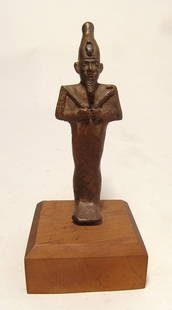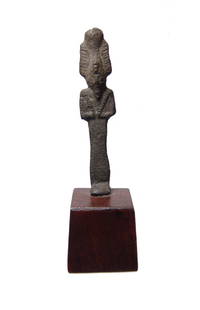
Osiris; Egypt, Late Period, 664-332 B.C. Bronze. It presents faults and losses.
Similar Sale History
View More Items in Sculptures & CarvingsRelated Sculptures & Carvings
More Items in Egyptian Sculptures & Carvings
View MoreRecommended Art
View More






Item Details
Description
Osiris; Egypt, Late Antique, 664-332 BC.
Bronze.
With faults and losses.
Measurements: 18 x 7 x 5 cm.
Moniform amulet statuette of Osiris, depicted with the attributes of the performer. An atef crown, with the solar disc and ostrich feathers, the whip (mayal or nenej) and the uas sceptre. These are the most characteristic iconographic attributes of this deity, representing the power and authority of Osiris as king of the gods and supreme authority over the earth and crops. Osiris is the Egyptian god of resurrection, associated with the fertility and regeneration of the Nile, protector of vegetation and agriculture. He also presides over the court of judgement of the dead, and is in fact closely associated with the afterlife. He is usually depicted mummified, with the attributes of royalty: Atef crown, hela staff and nejej whip or uas sceptre, as seen here. Osiris was considered the first-born son of Geb, divinity of the earth, and the goddess Nut, representation of the sky. He was therefore the brother and husband of Isis, with whom he had a posthumous son, Horus. We find him for the first time in the sources of the 5th Dynasty, although it is most likely that he was worshipped much earlier. In fact, we find the epithet Khenti-Amentiu ("leader of the Orientals", alluding to his role as king of the Beyond) already used in the 1st Dynasty, both in relation to divinity and as a pharaonic title. The most valuable information about Osiris is found in the Pyramid Texts of the late 5th Dynasty, the Shabaka Stone of the New Empire and, much later, in the texts of Greek writers such as Plutarch and Diodorus. Osiris was considered not only a merciful judge, but also the protector of the underworld, and thus the guarantor of the birth of vegetation and the flooding of the Nile. Also, in connection with his myth of rebirth after death, Osiris began to be associated with natural cycles, especially those related to agriculture.
In terms of his mythology, the cult of Osiris as the god of regeneration and rebirth is of particular interest because of his concept of immortality. Plutarch records a version of the myth in which Set, Osiris' brother, conspires with the queen of Ethiopia to assassinate him. Set tricked Osiris into putting himself inside a box, which he then closed, sealed with lead and threw into the Nile (this box is the origin of the Egyptian sarcophagus). Osiris' wife, Isis, found his corpse and used a spell to bring him back to life so that he could impregnate her. After this, the god died again and his wife hid his body in the desert. Months later, Isis would give birth to Horus, who would finally avenge his father.
Bronze.
With faults and losses.
Measurements: 18 x 7 x 5 cm.
Moniform amulet statuette of Osiris, depicted with the attributes of the performer. An atef crown, with the solar disc and ostrich feathers, the whip (mayal or nenej) and the uas sceptre. These are the most characteristic iconographic attributes of this deity, representing the power and authority of Osiris as king of the gods and supreme authority over the earth and crops. Osiris is the Egyptian god of resurrection, associated with the fertility and regeneration of the Nile, protector of vegetation and agriculture. He also presides over the court of judgement of the dead, and is in fact closely associated with the afterlife. He is usually depicted mummified, with the attributes of royalty: Atef crown, hela staff and nejej whip or uas sceptre, as seen here. Osiris was considered the first-born son of Geb, divinity of the earth, and the goddess Nut, representation of the sky. He was therefore the brother and husband of Isis, with whom he had a posthumous son, Horus. We find him for the first time in the sources of the 5th Dynasty, although it is most likely that he was worshipped much earlier. In fact, we find the epithet Khenti-Amentiu ("leader of the Orientals", alluding to his role as king of the Beyond) already used in the 1st Dynasty, both in relation to divinity and as a pharaonic title. The most valuable information about Osiris is found in the Pyramid Texts of the late 5th Dynasty, the Shabaka Stone of the New Empire and, much later, in the texts of Greek writers such as Plutarch and Diodorus. Osiris was considered not only a merciful judge, but also the protector of the underworld, and thus the guarantor of the birth of vegetation and the flooding of the Nile. Also, in connection with his myth of rebirth after death, Osiris began to be associated with natural cycles, especially those related to agriculture.
In terms of his mythology, the cult of Osiris as the god of regeneration and rebirth is of particular interest because of his concept of immortality. Plutarch records a version of the myth in which Set, Osiris' brother, conspires with the queen of Ethiopia to assassinate him. Set tricked Osiris into putting himself inside a box, which he then closed, sealed with lead and threw into the Nile (this box is the origin of the Egyptian sarcophagus). Osiris' wife, Isis, found his corpse and used a spell to bring him back to life so that he could impregnate her. After this, the god died again and his wife hid his body in the desert. Months later, Isis would give birth to Horus, who would finally avenge his father.
Buyer's Premium
- 26%
Osiris; Egypt, Late Period, 664-332 B.C. Bronze. It presents faults and losses.
Estimate €2,000 - €2,500
1 bidder is watching this item.
Shipping & Pickup Options
Item located in Barcelona, Barcelona, esOffers In-House Shipping
Payment

TOP








































![Art Deco-Style Bronze Archer Sculpture: Art Deco-style bronze archer sculpture, late 20th century, after "Spartiate" by Max Le Verrier (French, 1891-1973) modeled as a kneeling archer, unsigned. [16 1/4" H x 18 1/2" W x 8" D].](https://p1.liveauctioneers.com/1221/329897/177858956_1_x.jpg?height=310&quality=70&version=1715712931)







![Emilio Grau-Sala "Sur la Plage" Oil on Canvas: Emilio Grau-Sala (Spanish, 1911-1975), "Sur la Plage" [On The Beach], Oil on Canvas, 1958, signed "Grau Sala" lower right, signed, inscribed "Trouville", dated, and titled to verso. Image: 21.5" H x 2](https://p1.liveauctioneers.com/5649/328023/176731071_1_x.jpg?height=310&quality=70&version=1714409606)













